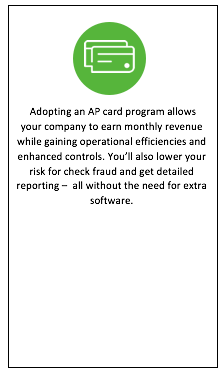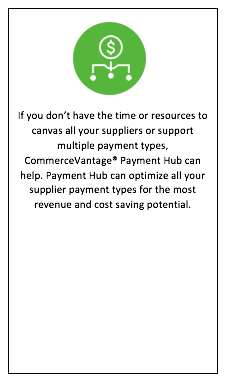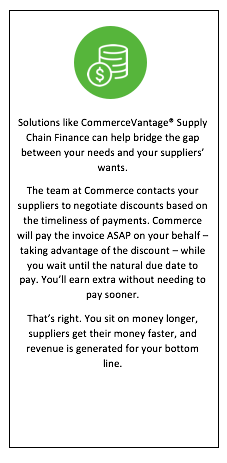The 5 Mistakes AP Departments Make
The 5 Mistakes AP Departments Make
![]()
If you’re not already, it’s time to start asking questions about your accounts payable. How do you pay your suppliers? When? How long does it take an invoice to be paid? What strategies do you have in place to maximize benefits?
Your AP department shouldn’t just focus on process. It should give your company leverage with suppliers and earn revenue for your bottom line. You can find cost savings and new opportunities within your everyday processes. You just need to know where to look.
Your AP department might be guilty of a few of these mistakes. Here are some tips to fix them, or better yet, avoid them altogether.
MISTAKE 1: PAYING ALL SUPPLIERS WITH CHECKS
While consumers are almost entirely moving away from checks, it’s tougher for corporations to make the change. But when businesses break it down, it’s easy to see why relying on checks is a mistake. From buying checks, stuffing envelopes, purchasing postage and physically mailing, checks cost valuable time and money that can be spent more strategically elsewhere.
Many companies adopt an ePayables or AP card program because these can generate revenue with cards instead of checks. Using other payment types aside from checks can help reduce costs and turn an accounts payable department into a revenue-generating entity within a company.
An ePayables or AP card program also has a higher level of fraud prevention, unlike checks. Checks are subject to many risks, both internally and externally. Fraudsters can simply lift bank account information from a check or forge a signature.
 MISTAKE 2: NOT USING REVENUE-GENERATING PAYMENT TYPES
MISTAKE 2: NOT USING REVENUE-GENERATING PAYMENT TYPES
If you’re not using additional payment types, you are paying for it through missed benefits. When it comes time to make a strategy, consider payment types that generate revenue before the ones that don’t.
Many successful AP departments create strategies around how and when to pay suppliers. Having a variety of payment methods may also bring different positive outcomes, like extending payment terms or receiving discounts. Early payment discounts, supply chain finance, and private network transactions can generate positive yields.
The end goal is to pay the right supplier the right amount at the right time with the right payment type and to take advantage of discounts, extended terms or revenue generating opportunities.
Continue to evaluate your payment options and supplier preferences.
The world of payments is an ever-changing landscape. Supplier acceptance trends and payment preferences are constantly evolving and growing.
MISTAKE 3: NOT TAKING ADVANTAGE OF EARLY PAYMENT DISCOUNTS 
Early payment discounts are more common than you might think. Purchasing departments work hard to negotiate discounts, so it’s important for AP departments to take advantage when they can.
It’s common when purchasing to negotiate a 10-day discount. The problem is, it’s difficult for many departments to approve and pay an invoice that quickly.
If your organization’s average invoice approval process takes as long as 20 days, it may seem unrealistic to do it twice as fast. But your suppliers want to get paid as fast as possible and they’ll make it worth your while.
Taking advantage of early payment discounts means big savings and improved supplier relations. If you can let your money go a few days early, you should. If you can’t, there’s still a way for you and your suppliers to meet in the middle.
 MISTAKE 4: NOT SUBMITTING A SPEND FILE TO YOUR PROVIDER REGULARLY
MISTAKE 4: NOT SUBMITTING A SPEND FILE TO YOUR PROVIDER REGULARLY
As you add and change suppliers over time, it’s important to let your AP program provider know. Failing to do this regularly impacts your provider’s ability to accurately size your program. This can affect pricing, revenue share and other opportunities.
Timing is critical when you add a new supplier. The earlier you start the conversation about your preferred payment method, the more open they may be to accept an electronic payment instead of a check.
Your suppliers’ acceptance practices may change over time as well. By regularly submitting a spend file, you may uncover new opportunities to cut more checks out of your process.
Make a practice to submit a spend file to your provider on a regular basis. You may be happy with the spend mix and revenue share that comes with an AP program – but without regular checkups, your revenue may erode year-over-year due to suppliers opting out, your organization changing suppliers and more.
MISTAKE 5: ENROLLING SUPPLIERS ONCE + NEVER AGAIN
Many AP programs include enrollment, but they only include it once. It’s common for a 5-year-old AP program to lose efficiency and impact year over year.
So how do you combat this?
Companies take on new suppliers or replace old ones regularly. Not having an AP program that incorporates ongoing enrollment can be detrimental to your strategy.
Additionally, suppliers that enrolled initially may unexpectedly change policies and decide to pull out of your program. If you’re not continuously enrolling new suppliers and reassessing current ones, there is no opportunity to capture additional volume. Your AP program will naturally become less effective due to this supplier erosion.
As the industry grows and learns, there are additional opportunities for innovation that may accommodate more suppliers and create more revenue opportunities.
Find a provider who goes the extra mile with your AP program, and make sure their enrollment methods fit your business. Beware of methods like the following:
- Only enroll the top 20 percent of your suppliers
- Choose a dollar threshold to target
- Outsource the enrollment campaign to another organization
- Rely on you to enroll vendors yourself
- Only offer one payment type that may not be compatible with many of your suppliers
CommerceVantage® AP solutions can remedy a variety of pain points in your AP. Backed by a stable banking institution, Commerce uses its payments knowledge and supplier relationships to bring the best out of its clients’ AP.
With multiple payment types and ongoing enrollment, Commerce can get more suppliers to move away from checks and use revenue-generating payment options. Our efficient technology will help you take advantage of early-pay discounts while working with your current accounting system. To make sure your program doesn’t stall, the Commerce account management team will work with you to update your suppliers and our enrollment team will continually enroll for years to come.
From there, Commerce can help identify other areas for streamlining and savings and make sure you’re fulfilling your revenue potential. We’ve made payments our business so you can make your business better.
Reach out to a Commerce Bank representative to get started on a free, no-obligation spend analysis and see what we can do for you.
 Robin Wandschneider is the senior vice president of Commerce Bank.
Robin Wandschneider is the senior vice president of Commerce Bank.













